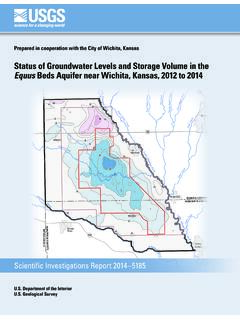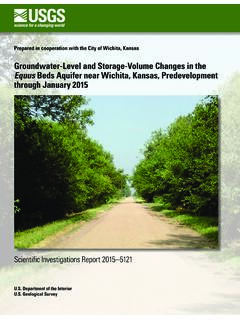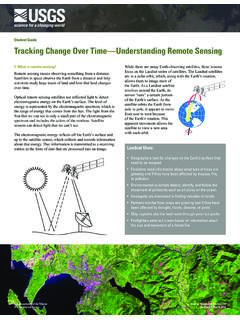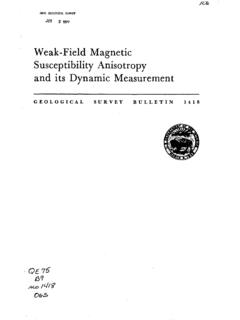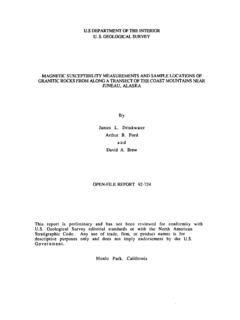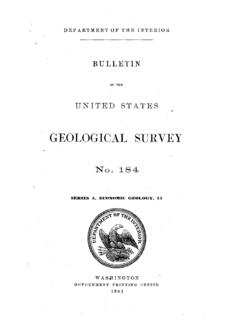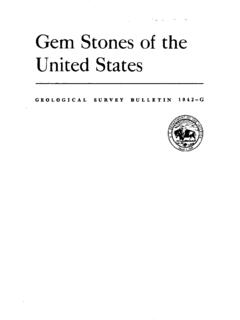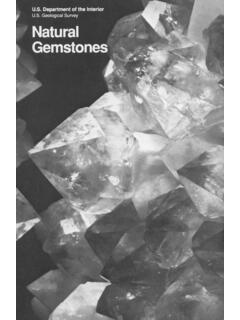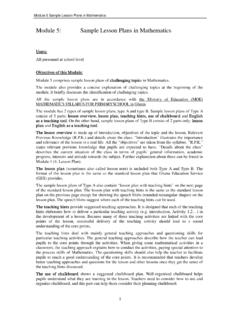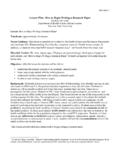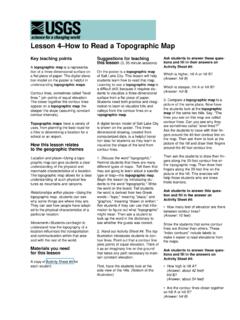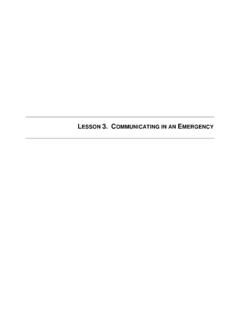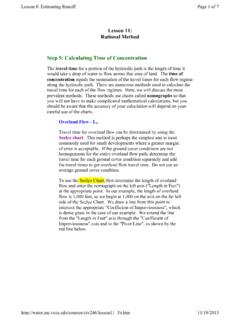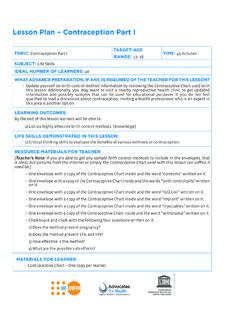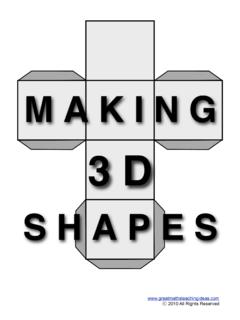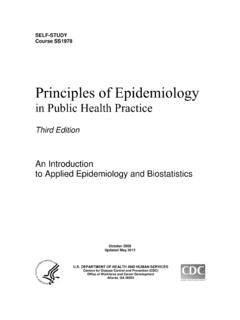Transcription of Volcanoes!: Lesson 1 - USGS
1 Department of the Interior Geological Survey clIVArtIWO THE Eli II tii fig. 1 Inside the Earth Inner Core (solid) Outer Core (liquid) Mantle (solid) Upper Mantle (soft) Crust (hard) Magma is generated in the Earth's lithosphere, which is made up of the crust and upper mantle. Until the spring of 1980, most people thought of Mount St. Helens as a serene, snow-capped mountain and not as a lethal volcano. The mountain had given little evidence that it posed a hazard for more than a century a long time in human terms but a blink of an eye in terms of the mountain's 40,000-year geo-logic history.
2 A series of earthquakes that began in mid-March of 1980 sound-ed the alarm that Mount St. Helens was awakening from its sleep. In other words, Mount St. Helens, which had been dormant, became active and likely to erupt. Its catastrophic eruption 2 months later was a reminder that a fiery world lies beneath the Earth's surface. Why volcanoes Occur The roots of Mount St. Helens are 110 to 330 kilometers (70 to 200 miles) below the Earth's surface. Here in the Earth's mantle (fig. 1) temperatures arc hot enough to melt rock and form a thick, flowing substance called magma. Lighter than the solid rock that surrounds it, Lesson 1 magma is buoyant much like a cork in water; being buoyant, it rises.
3 As the magma rises, some of it col-lects in large reservoirs, or magma cham-bers (poster fig. I) that fuel volcanoes . As the rising magma nears the Earth's sur-face, pressure decreases, which causes the gases in the magma to expand. This expansion propels the magma through openings in the Earth's surface: a vol-canic eruption occurs. Once magma is erupted, it is called lava. Where volcanoes Occur Volcanic eruptions occur only in certain places and do not occur randomly. That's because the Earth's outermost shell the lithosphere is broken into a series of slabs known as lithospheric or tectonic plates.
4 These plates are rigid, but they float on the hotter, softer layer in the Earth's mantle. (poster fig. 2) As the plates move about, they spread apart, collide, or slide past each other. volcanoes occur most frequently at plate boundaries. Some volcanoes , like those that form the Hawaiian Islands, occur in the interi-or of plates at areas called hot spots. (poster fig. 2) Although most of the active volcanoes we see on land occur where plates collide, the greatest number of the Earth's volcanoes are hidden from view, occurring on the ocean floor along spreading ridges. Mount St. Helens is typical of more than 80 percent of the volcanoes that have formed on land.
5 Known as subduc-tion zone volcanoes , they occur along the edges of continents where one plate fig. 2 Inside the Earth Mount St. Helens North American Plate Magma Juan De Fuca Plate About 240 kilometers (150 miles) west of the northwest coast of the United States, the Juan de Fuca Plate plunges beneath the North American Plate. Mount St. Helens is among the volcanoes that have formed as a result. dives, or subducts, beneath a second plate. (fig. 2). When the subducting plate reaches about 100 kilometers (60 miles) into the Earth's hot mantle, it triggers partial melting of the overlying plate and forms new magma.
6 Some of the magma rises and erupts as volcanoes . Why Some volcanoes Erupt Sonic volcanoes , like Mount St. Helens, tend to be explosive when they erupt, whereas others, like Hawaii's Kilauea, tend to be effusive (loosely flowing) and nonexplosive. How explosive an eruption is depends on the magma's chemical composition and gas content, which in turn affect the magma's stickiness, or vis-cosity. All magma contains gases that escape as the magma travels to the Earth's sur-face. If magma is fluid (as is Kilauea's), gases can escape relatively rapidly. As a result, lava flows instead of exploding during an eruption.
7 If magma is viscous (as is Mount St. Helens), the gases can-not escape easily; pressure builds inside the magma until the gases sometimes escape violently. In an explosive eruption, the sudden expansion of gases blasts magma into air-borne fragments called tephra, which can range in size from fine particles of ash to giant boulders. After the initial explosive phase of the eruption, however, quieter lava flows can follow. In both explosive and nonexplosive (effusive) eruptions, volcanic gases, including water vapor, are released into the atmosphere. Three Types of volcanoes Repeated volcanic eruptions build vol-canic mountains of three basic types, or shapes, depending on the nature of the materials deposited by the eruption.
8 Shield volcanoes (poster fig. 5), such as Kilauea, form by effusive eruptions of fluid lava. Lava flow upon lava flow slowly builds a broad, gently sloping vol-canic shape that resembles a warrior's shield. Stratovolcanoes (poster ), such as Mount St. Helens, build from both explo-sive and effusive eruptions. Layers of tephra alternating with layers of viscous lava flows create steep-sided, often sym-metrical cones that we think of as the classic volcano shape. In his log of the Lewis and Clark Expedition, William Clark wrote: "Mount St. Helens is per-haps the greatest pinnacle in America.
9 " The smallest volcanoes , cinder cones (poster fig. 4), such as Sunset Crater in Arizona, form primarily from explosive eruptions of lava. Blown violently into the air, the erupting lava breaks apart into fragments called cinders. The fallen cinders accumulate into a cone around the volcano's central vent. Cinder cones can form on the flanks of shield and stratovolcanoes. Activity 1 low voicanoes Grow 45-minute work session 45-minute demonstration and discussion In small groups, students build models of the three major types of volcanoes and see how a volcano's shape is related to the type of material it erupts.
10 As a class, they observe a demonstration that simu-lates the nature of two volcanic materials: lava and tephra. The Lesson concludes with a discussion of how a volcano's shape is related to the nature of the mate-rial it erupts. Key teaching points 1. A volcano is a circular or linear open-ing in the Earth's surface through which lava, rock fragments, ash, aerosols, and gases erupt. 2. A volcano is also the landform, often a mountain, built from repeated eruptions. 3. Some eruptions are explosive, some are effusive (loosely flowing) and nonex-plosive, and some are both explosive and effusive.
